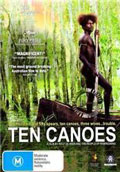
Directed by
Rolf de Heer / Peter Djiggir
92 minutes
Rated M
Reviewed by
Sharon Hurst


Ten Canoes
Synopsis: In a time long ago, in the Arafura swamplands of Arnhem Land, a group of men build ten canoes to go into the swamps hunting goose eggs. One young man, Dayindi (Jamie Gulpilil) is lusting after his older brother’s wife. The tribal elder Minygululu (Peter Minygululu) tells him a story of their ancestors, when a similar situation occurred. In that semi-mythological ancient time Yeeralparil (also played by Jamie Gulpilil) lusted after one of the three wives of tribal warrior Ridjimiralil (Crusoe Kurddal). In attempting to teach the boy something, the old man tells a story with plenty of drama: wife stealing, sorcery, and tribal revenge.
Rolf De Heer is well known for his sometimes challenging films such as Bad Boy Bubby and Alexandra’s Project, but nothing can quite prepare you for this outstanding film. Responding to a request by famed actor David Gulpilil to make a film with his people on their traditional land, de Heer based his story on a series of photos taken in the 1930s by anthropologist Dr Donald Thomson. In collaboration with the local people, and particularly one of the actors Peter Djiggir (credited as co-director), de Heer scripted a story which essentially is inspired by the photos, and shows a remarkable insight into a way of life few white people would have seen.
Although in one sense the film could be seen as veering heavily into anthropological territory, it has a simple but captivating plot (well, actually, two parallel and interweaving plots) which contains warmth, humour and interest a-plenty. De Heer uses a device to separate the two time periods – the more recent time is filmed in black and white; the ancient story in color. The black and white scenes are so richly textured one feels the old photos have come to life whilst many of the colored shots are like landscape paintings from the glorious opening aerial shots tracking a river through the verdant landscape, to the almost sighing swamps with their limpid reflections, to the vivid red of the dusty earth where roads have been opened.
But it is the people who impress so intensely. Using only members of the tribe originally photographed by Thomson, who moreover according to tribal protocol could only be portrayed by individuals related to them, de Heer elicits natural and completely convincing performances from all. The script allows for much humour and insight into a people who, though their daily lives seem so removed from ours, we can relate strongly to: the men endlessly carping about their women, making fart jokes, and stirring each other about impotence; the women berating their men for their uselessness. Whilst the camera keeps its distance for landscape shots, it makes the most of intense close-ups of beautiful faces, and in the case of Birrin Birrin, the honey eater, very rotund tummies!
Crusoe Kurdall is especially fine as the intense and handsome warrior, Ridjimiralil, who exacts revenge for the loss of his wife, though all the cast do a splendid job. The voice-over narration by David Gulpilil helps us follow the story, and sometimes digs affectionately and amusingly at the white audience.
Very importantly, Ten Canoes is the first film to ever be shot in an Australian Aboriginal language. This, combined with the stunning images of indigenous life, especially scenes involving death and its rituals, make for a film which is not only rivettingly but important as a groundbreaking presentation of indigenous culture.
Want something different?





